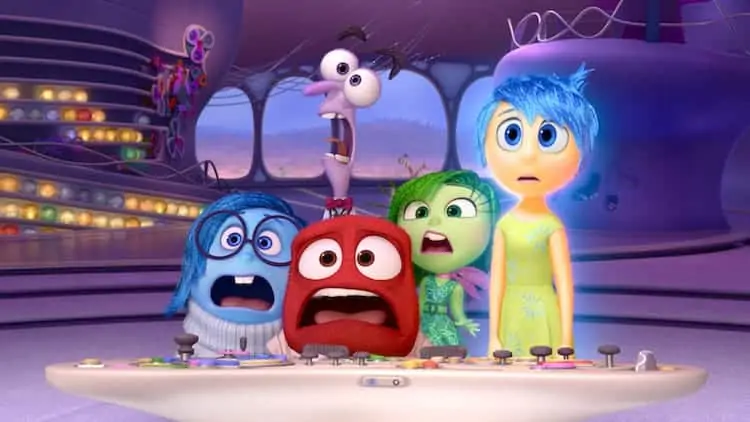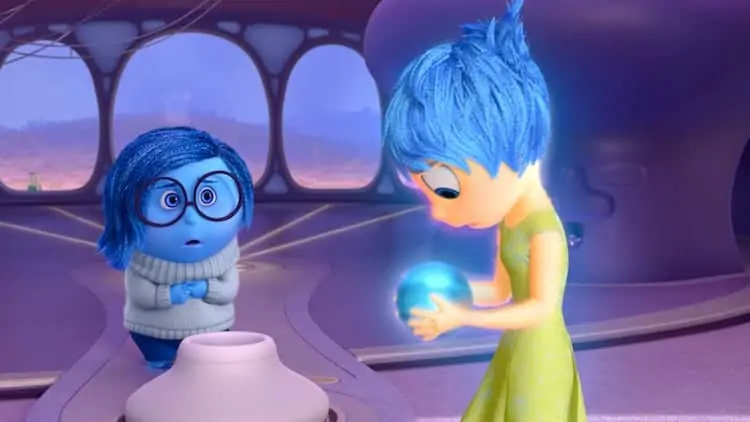Pixar is back! Not that it ever really left, but with a recent slew of sequels and a Scottish princess movie that, for many, seemed like an odd fit for the studio, it’s nice to see them back to their original story-telling roots. And Inside Out, their fifteenth feature, is arguably their most clever and inventive film yet.
Set in the mind of an 11-year-old girl named Riley, five Emotions are hard at work, led by lighthearted optimist Joy (Amy Poehler), whose mission is to make sure Riley stays happy. Fear (Bill Hader) is in charge safety, Anger (Lewis Black) ensures all is fair and Disgust (Mindy Kaling) prevents Riley from getting poisoned—both physically and socially. The last of the Emotions is Sadness (Phyllis Smith) and she isn’t exactly sure what her role is, and frankly, neither does anyone else.
When Riley’s family relocates to a scary new city, the Emotions are at the helm of an “it’s a small world” meets Apple Store operating console, eager to help guide her through the difficult transition. Her memories, represented by glowing orbs each colored according to the prominent emotion, are stored in her mind with the most important ones – the “core memories” – functioning to create entire islands that represent the core of Riley’s personality. But when Joy and Sadness are inadvertently swept into the far reaches of Riley’s mind—along with some of her core memories—Fear, Anger and Disgust are left reluctantly in charge (and it shows outwardly in Riley’s real life).

Joy and Sadness venture through unfamiliar places like Long Term Memory, Imagination Land, Abstract Thought and Dream Productions in a desperate effort to get back. On the way they meet some colorful characters from the Forgetters, who are Mind Workers in charge of sorting Riley’s memories, to Riley’s imaginary friend named Bing Bong, who is searching for a way to make Riley remember him.
Now, if all of that makes you want to scratch your head in confusion, fear not, as Inside Out does an excellent job of laying things out logically and in visually interesting ways, from character design to the various mind concepts (there is a literal ‘Train of Thought’ choo-chooing around Riley’s head). The combination of all these clever and inventive ideas is what make Inside Out easily hold its own amongst the Pixar elite. And it’s funny too. For example, a scene involving the Forgetters has them purging Riley’s memory of contact numbers because “they’re all in her phone anyway.” There are plenty of jokes aimed just for adults too (i.e. “Bears” in San Francisco?). Although the film spends most of the time inside the colorful world of Riley’s mind, the outside plot Riley’s adjusting to her new life is arguably the most sophisticated in comparison to its contemporaries.
But what really sets Inside Out apart from its Pixar predecessors is its emotional complexity and the “stickiness” of the concepts they present. Separation anxiety, as presented in Toy Story and Finding Nemo, seems like an elementary concept when compared to message that Inside Out postulates (I won’t spoil it here but it has to do with the relationship between Joy and Sadness). Furthermore, I couldn’t help but wonder to myself what core memory islands are inside my own mind or what my imagination land might look like or if there’s an imaginary friend desperate to be remembered? Inside Out is a brilliant visual metaphor and an amazing tool for children (and parents) to help explain why they might be feeling as they do. And that is just one of this film’s greatest strengths. It’s a film that it continues to engage the audience on an intellectual level long after the credits.

Whether or not Inside Out is Pixar’s best film is debatable, but it’s certainly in that debate. If I’m being critical, I’d say some of their earlier films have much grander narrative scopes and stronger character appeal. However, I am positive that there will be a substantial number of audiences who slot this film as their #1 (I’m still partial to an environmentally conscious robot).
Inside Out was directed by Pete Docter (Up, Monsters, Inc.), produced by Jonas Rivera (Up), co-directed by Ronnie Del Carmen (Dug’s Special Mission) and executive produced by John Lasseter (Toy Story, Cars) and Andrew Stanton (Finding Nemo, WALL•E). The screenplay was penned by Docter, Meg LeFauve and Josh Cooley from an original story by Docter and Del Carmen. Academy Award®–winning composer Michael Giacchino (The Incredibles, Ratatouille, Up) provided the score. It’s available on Blu-ray 3D, Blu-ray Combo Pack and On-Demand today, November 3rd!